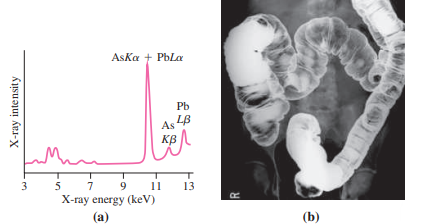With sufficient energy, it?s possible to eject an electron from an inner atomic orbital. A higher-energy electron
Question:
With sufficient energy, it?s possible to eject an electron from an inner atomic orbital. A higher-energy electron will then drop into the unoccupied state, emitting a photon with energy equal to the difference between the two levels. For inner-shell electrons, photon energies are in the keV range, putting them in the X-ray region of the spectrum. These characteristic X rays are labeled with the letter indicating the shell to which the electron drops, followed by a Greek letter indicating the higher level from which it drops; thus Ka designates a transition from the L shell to the K shell. Characteristic X rays provide scientists and physicians with an important diagnostic tool. Environmental scientists bombard pollution samples with high-energy electrons, knocking out inner-shell electrons and thus producing X-ray spectra that help identify contaminants (Fig. 36.20a). Geologists do the same with rocks. Medical radiologists reverse the process, exploiting the fact that X rays cause inner-shell transitions as well as complete ejection of inner-shell electrons. In particular, radiologists use the element barium in this way to produce high-contrast X-ray images of the intestinal tract (Fig. 36.20b).
?
Molybdenum?s X-ray spectrum has its K? peak at 17.4 keV. The corresponding X-ray wavelength is closest toa. 1 pm.b. 100 pm.c. 1 nm.d. 100 nm.
Step by Step Answer:






